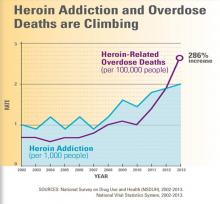Definition
Opioid addiction is a primary, chronic, neurobiological disease, with genetic, psychosocial, and environmental factors influencing its development and manifestations.
It is characterized by behaviors that include one or more of the following:
- Impaired control over drug use
- Compulsive use
- Continued use despite harm
- Craving
Reference:
American Academy of Pain Medicine, American Pain Society, & American Society of Addiction Medicine. (2001). Public policy statement on definitions related to the use of opioids in pain treatment. Retrieved October 5, 2007, link updated May 30, 2019: https://www.asam.org/advocacy/find-a-policy-statement/view-policy-statement/public-policy-statements/2011/12/15/definitions-related-to-the-use-of-opioids-for-the-treatment-of-pain-consensus-statement
Opioid Use Disorder Diagnostic Criteria
Access opioid use disorder (OUD) diagnostic criteria here: https://www.cdc.gov/drugoverdose/training/oud/accessible/index.html
Addiction: A Neurobiological Disease
- Involves the brain’s reward (limbic) center
-
- An area of the brain that is associated with the affective responses to pain
- Involves dopamine
- Susceptible individuals may have an alteration of the limbic or related system that causes sensitization to the reinforcing effects of drugs
Addiction is a neurobiological (physiological) disease. It is important to understand that genetic, sociocultural, and environmental factors may contribute to the onset and progression of addiction. Addiction involves stimulation of the brain’s reward center, a component of the limbic system that generates affect or emotions. The reward circuit is mediated by the neurotransmitter, dopamine. Certain drugs such as opioids and other “abusable” substances can stimulate this reward system. Alterations in the brain’s reward center (limbic system) may result in more susceptibility to addiction. Genetic, social, cultural, and environmental factors may all alter the circuits contributing to the development of addictive disease.
Reference
Ballantyne, J. C., & LaForge, K. S. (2007). Opioid dependence and addiction during opioid treatment of chronic pain. Pain, 129(3), 235-255.
Opioid Epidemic

How big is the opioid epidemic?
- From 1999-2011 the rate consumption of hydrocodone more than doubled and consumption of oxycodone increased 500%
- During same time frame, opioid related death rate nearly quadrupled
- 1997 to 2011, there was a 900% increase in individuals seeking treatment for addiction to opioids
Reference
SAMHSA, 2013 https://www.samhsa.gov/data/sites/default/files/2013MHDetTabs/NSDUH-MHDetTabs2013.pdf, CDC Injury Prevention & Control: Opioid Overdose http://www.cdc.gov/drugoverdose/data/heroin.html
Challenges Encoutered with Patients with OUD
- Altered nociception threshold
- Physical dependence and withdrawal
- Tolerance
- Impaired immune response
- Polysubstance use is common
- Behavioral issues
-
- Drug seeking
- Poor coping skills
Note: Failure to account for tolerance is a common cause of confrontational behavior when treating patients with addiction.
Reference
Compton P, Canamar CP, Hillhouse M, Ling W. Hyperalgesia in heroin dependent patients and the effects of opioid substitution therapy. J Pain 2012;13(4):401-409. PMID: 22424799 PMCID:PMC3334366 DOI:10.1016/j.jpain.2012.01.001
Hay JL, White JM, Bochner F, Somogyi AA, Semple JT, Rounsefell B. Hyperalgesia in opioid-managed chronic pain and opioid-dependent patients. J Pain 2009;10(3):316-322. PMID: 19101210 DOI:10.1016/j.jpain.2008.10.003
Jage J, Bey T, Postoperative analgesia in patients with substance use disorders: Part II. Acute Pain 2000;3(4):172-180. https://doi.org/10.1016/S1366-0071(00)80021-2

